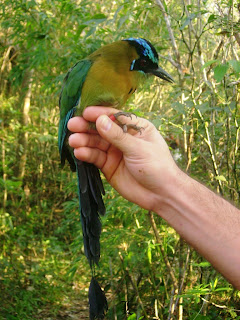A trip looking for motmot species
A trip looking for motmot species
by L
Some days ago I was traveling with some colleagues in the Guatemalan thorn forest and we had a lucky day. We got pictures from the Russet-crowned motmot (which was a lifer for one of us) and we got pictures of many cuculidae from the country and of course we got a good game of bird data to our research.
Well, we started to dream the ideal schedule to watch all the motmot species in the country. There are nine motmot species and more of them are easy to watch in Guatemala. For those who are not familiarized with motmots they have the unique characteristic to develop a racket-like rectris feathers. This family can be watched only in America and they originated in Mesoamerica in some recent point no more than 30 million years.
 |
| Turquoise-browed Motmot tail. All motmot tail feathers have different blue tones. |
Early in the 20 century there was scientific observations which wrongly lead to the conclusion that motmots work out in shaping their rectris feathers as a behavior. Later on, detailed studies demonstrated the keratin in the barbs is weak and facilitates to fall. Are weak in some specific points and is the primary cause for this racket-like shape.
If I could have the opportunity to search for all the motmot species I would start the route looking for the Blue-throated motmot (Aspatha gularis). This bird is restricted to the mountains above 1500 m and can be easily seen in all the Guatemalan highlands. Is not a rare bird, easy to find by call, relatively easy to find on the wires. The closer site to Guatemala City to watch the bird would be the Alux Mountain Water protection area (40 Kilometers) but all forested sites around Antigua Guatemala and Atitlan Lake which are farther are also good places and almost are always included in all travel schedules in the country.
 |
| Blue-throated Motmot, I take this shot at the window close to home in Santiago, Sacatepéquez in Alux Mountain. |
While making this travel you can also add easily at the highlands: Pink-headed Warbler (Ergaticus versicolor), Rufous-collared Robin (Turdus rufitorques), Bushy-crested Jay (Cyanocorax melanocyaneus), Green-throated Mountain-gem (Lampornis viridipallens), Northern (Guatemalan) Flicker (Colaptes auratus) and other dozen species characteristics from the mountains and more than fifty characteristic from Mesoamerica.
 |
| Russet-crowned Motmot, this shot was made in an regional park biodiversity survey. |
 |
| Russet-crowned Motmot, look at the beauty details of the bird face. This bird was captured during a biodiversity contribution of regional park evaluation in the Motagua Valley. |
The second target for me should be the Russet-crowned Motmot (Momotus mexicanus). This bird is restricted to dry areas and in the country the Motagua Valley thorn forest is the driest place in all Central America. The Niño Dormido regional park closet o Cabañas Village or La Laguna regional park closet o San Agustin Acasaguastlán are close to the road (100 Km from the City), safe and nice places recommended for the birdwatching activity. Even if you are not looking for it the Turquoise-browed Motmot (Eumomota superciliosa) is everywhere in the dry forest and will be the third check in the list without effort.
 |
| Turquoise-browed Motmot, this specimen was captured in an evaluation of bird conservation contribution from regional park in thorn shrubs coverage in Motagua Valley. |
The next place to visit will be the Atlantic slope jungle. The Carboneras site located in Cerro San Gil Reserve is probably the best place (300 Km away from the City). This place is in the hearth of a well preserved area where a basic infrastructure has been developed. It is necessary a one hour 4x4 vehicle ride and a couple hour walk but a couple days there will produce the rest of birds: Blue-crowned Motmot (Momotus momota), Tody Motmot (Hylomanes momotula), Keel-billed Motmot (Electron carinatum).
 |
| Tody Motmot, this is not the best picture. We captured this specimen in an inventory project in Volcan Atitlan at the South. |
The Broad-bill Motmot was reciently registered in Guatemala and the best places to watch it here are Sierra del Caral and maybe Punta de Manabique. The first one is a hard access place and the second one has no real infrastructure but is a very nice marine landscape.
In this point you are so close to the Mayan jungle (200 Km) and It worth to finish the travel there and add easily Rufous-breasted Spinetail (Synallaxis erythrothorax), Yucatan Flycatcher (Myiarchus yucatanensis), Yucatan Nightjar (Caprimulgus badius), Rose-throated Tanager (Piranga roseogularis), Gray-throated Chat (Granatellus sallaei), Ocellated Turkey (Meleagris ocellata) and other hundred species.
 |
| Blue-crowned Motmot, specimen captured in a migratory ringing project in Peten northern lowlands. |
 |
| Blue-crowned Motmot, look at the short naked raquis. |
The other two motmots just can be seen southern. The closest place to watch de Rufous Motmot, (Baryphthengus martii) is the southern Hounduras, so to watch it maybe will require a couple days more. And the Rufous-capped Motmot, (Baryphthengus ruficapillus) just can be seen at eastern Southamerica, so, in practical terms should very hard to add to the list in one trip.
Facts
- The racket-like shape rectrices characteristic tail from Motmots is due to the physical weak base in feather barbs
- The Motmots nests on burrows excavated in banks and dead trees, always close to the ground.
Further reading
- Beebe, W. (1910). "Racket formation in the tail-feathers of the motmots". Zoologica 1 (5): 140–149.
- Murphy, Troy G. (2007). Lack of melanized keratin and barbs that fall off: how the racketed tail of the Turquoise-browed motmot Eumomota superciliosa is formed. Journal of Avian Biology 38:139–143.
www.birdwatchingguatemala.com is a registered trademark of Martsam Tour & Travel Copyright® 2012 www.birdwatchingguatemala.com www.martsam.com



Comments